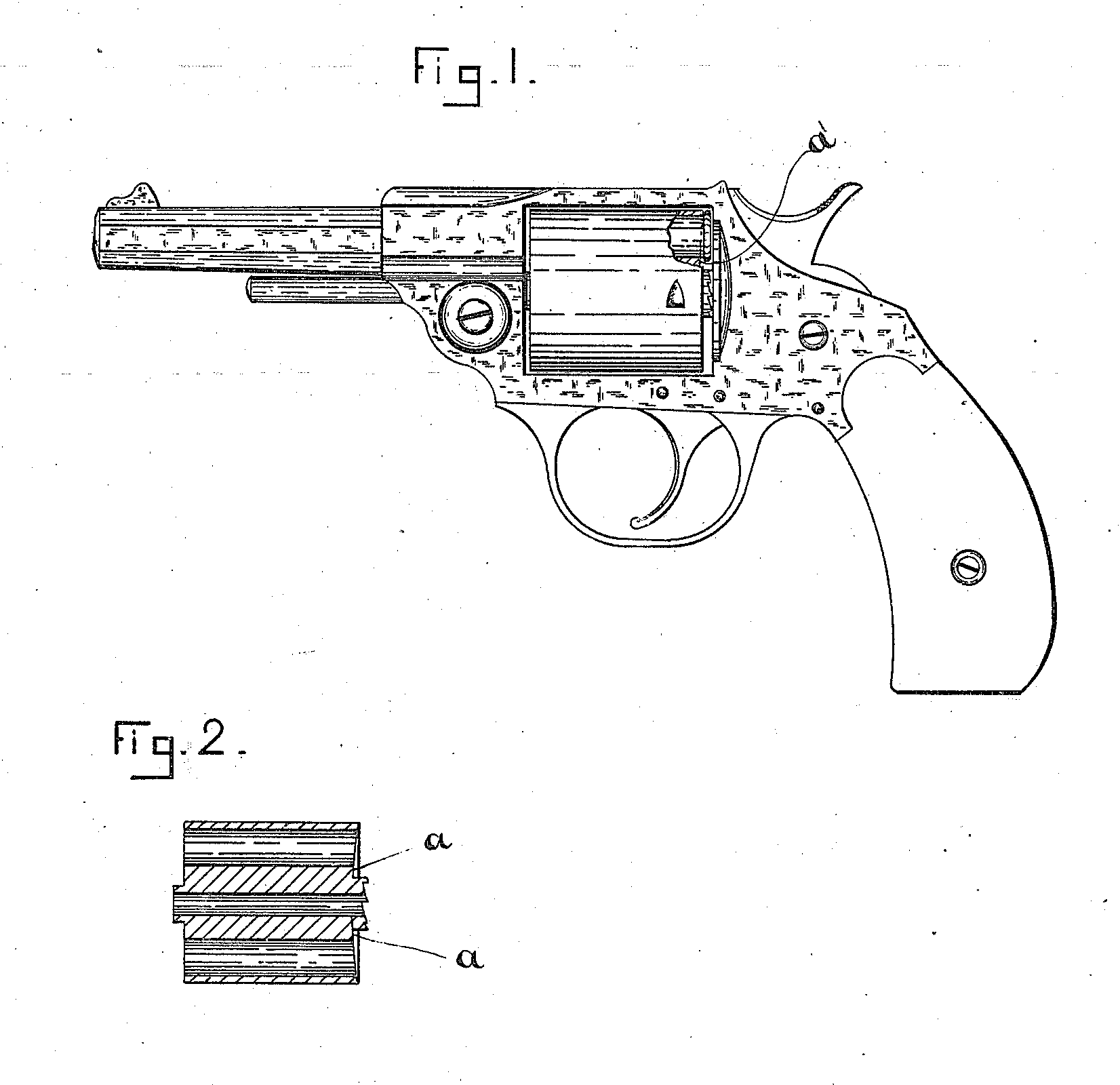US 294188
UNITED STATES PATENT OFFICE.
WILLIAM. H. BLISS, OF NORWICH, CONNECTICUT.
REVOLVER.
SPECIFICATION forming part of Letters Patent No. 294,188, dated February 26, 1884.
Application filed December 17, 1883. (No model.)
To all whom it may concern:
Be it known that I, William. H. Bliss, of the city of Norwich, county of New London, and State of Connecticut, have invented a certain new and useful Improvement in Revolving Fire-Arms, which improvement is fully set forth and described in the following specification, reference being had to the accompanying drawings, in which—
Figure 1 is a side view of an arm containing my improvement, a portion of the cylinder being cut away to illustrate more clearly my new invention. Fig. 2 is a longitudinal sectional view through the center of said cylinder.
My improvement relates particularly to the rear end of the revolving cylinder of an arm, my immediate object being to so construct said cylinder that only that portion of the head of the shell which is to be struck and indented by the hammer-nose in the act of firing rests against the cylinder, thus forming a solid anvil against which that portion of the head of the shell rests, and requiring a much lighter mainspring than is ordinarily used.
In self-cocking arms it is especially desirable that the mainspring should be as light as possible, as the entire strain of said spring must be overcome by pressure on the trigger, and as the tendency to deflection in the arm increases in proportion to the increased strength of mainspring it becomes, in consequence, almost an impossibility to preserve a correct aim in the act of firing.
Briefly stated, my improvement consists in “concaving the rear end of the cylinder,” as shown in Fig. 2. (See a.) Said rear end, as heretofore constructed, (or rather as it has been the intention of manufacturers to make it,) has been at right angles with the axial or base pin on which it rotates, the purpose being to give the flange of the shell an equal bearing against the cylinder at all points in its circumference. It has been the general custom to “square up” the ends of said cylinder with a side tool of the usual form; but as said tool is fed outward and the chip grows lighter there is an inclination on the part of said tool to “draw in” slightly, leaving the end of the cylinder somewhat convex instead of square across. In such a cylinder the cartridge-heads would find a bearing only on the side nearest the center of the cylinder. Even if the end of said cylinder is formed perfectly Square with the axial pin, a little dirt or grit, or even the tallow with which the cartridges are covered, often finds its way under the cartridge-head and forms a cushion against which the head is driven when struck by the hammer-nose. Such a condition and construction of cylinder calls for a mainspring of greater strength than would be required if the cartridge-head could invariably find a solid anvil against which to rest as it is struck in in the act of firing. By making the rear end of the cylinder concave or cup-shaped, the flange of the shell finds a bearing only on the outer edge of the cylinder at the precise point opposite where its periphery is to be indented by the hammer-nose. In such a form of cylinder the collecting of dirt or grit can do no harm, and as the cartridge must at all times rest against a Solid anvil, a quick-acting light mainspring Will produce a better result than a thick stiff mainspring with the form of cylinder now in common use.
Having thus described my invention, I claim as new and Wish to secure by Letters Patent—
In a revolving fire-arm, a cylinder whose rear end is so concaved or cupped that the flanges of the cartridge-shells find a bearing only on the outer edge of said cylinder, forming an anvil immediately opposite that part of the cartridge-head which is to be struck and indented by the falling hammer, as described.
WILLIAMI H. BLISS,
Witnesses:
Frank H. Allen,
A. Walt. Pearson.

